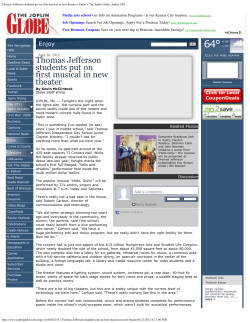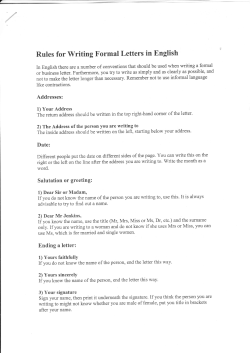
ID # 2A
Score of 8 ID # 2A Whether we like to think about it or not slavery is associated with our country's history. There have been several opinions on its constitutional fairness but nevertheless it happened and eradicating it from this nation was a struggle. During this struggle Benjamin Banneker took a huge step and wrote Thomas Jefferson about his negative feelings on the issue of slavery in which he implemented several religious allusions, repetition, and an array of emotional diction. Banneker makes several religious allusions that attack Jefferson's pro-slavery stance. He states that while Jefferson is "fully convinced of the benevolence of the Father" to all mankind, he "counteracts his mercies" by condoning slavery to continue. This skilled religious appeal serves a dual purpose. The first of which bends Banneker and Jefferson under a common God. This serves to show Jefferson that Banneker has a mutual religious understanding. But while the aforementioned quote ties the two men together, it also scorns Jefferson. Banneker chooses to attack Jefferson under the eyes of God so that he can maintain a polite air while also reprimanding Jefferson. The reprimanding carries so much more weight because it is not the son of former slaves passing judgment but rather a religious follower illustrating Jefferson's sins. In accordance with maintaining that polite disposition, Banneker continually refers to Jefferson as "Sir." Banneker opens his letter with "sire" and repeats it six times before concluding it, saying it at least once in every paragraph. This serves to show that while Banneker does not condone Jefferson's practices he still has the utmost respect for him and the position he holds. He does not work to antagonize Jefferson but rather reason with him and state his opinion. Continually repeating "sir" shows Jefferson that he is a dignified person which destroys the possible notion that race makes people inferior. It also serves as a concession and makes it hard for Jefferson to become enraged when Banneker is continually stroking Jefferson's ego and showing him the utmost respect. Banneker also utilizes emotional diction in his argument against slavery. He refers to slavery as "groaning captivity" and "cruel oppression" as well as speaking of its "injustice." All of these words were specifically chosen to represent the plight of the slave as well as depicting the horrendous life they must endure daily. The harsh words are made personal when he states that they affect "[his] brethren." Now the slaves in question are not just figures in the distance but are people with feelings and connections to other people. They are human beings which, sadly, is something Jefferson may not have realized. Banneker vividly depicts what Jefferson's' actions are doing to real life people which is intended to instill some much needed guilt as well as calling for radical and instrumental change. Score of 5 ID # 2B Benjamin Banneker uses many rhetorical strategies to argue against slavery. One important strategy he used was to relate the time in which the "tyranny of British Crown" ruled America to "a state of slavery" in his first two paragraphs. Since "the injustice of a state of slavery" is what Banneker is ultimately arguing for, he uses this terminology to logically appeal to Jefferson. Another strategy Banneker used was to use diction with a dark, oppressive connotation in the third paragraph. He uses phrases such as, "Counteract his mercies in detaining by fraud and violence," "groaning captivity and cruel oppression," and "criminal act which you professedly detested" to place blame on Jefferson and show how wrong slavery and unequal treatment of humans really is. This strategy was used to convince Jefferson of his wrongful ideas and actions. Banneker uses understatement in the first sentence of the fourth paragraphs as another rhetorical strategy. He states, "Sir, I suppose that your knowledge o the situation of my brethren is too expensive to need a recital here..." This statement purposefully makes readers think about the awful situations that slaves endure as a result of the institution without outright stating those situations and making a big deal out of it. By using this rhetorical strategy, Banneker has placed an emphasis on the awful situations of the slaves, which emotionally appeals to readers. Banneker uses hyperbole at the end of his first paragraph to emphasize just how wonderful it is to have freedoms in America. He states, "you cannot but acknowledge that the present freedom...which you enjoy you have mercifully received and that is the peculiar blessing of Heaven." Of course our freedoms in America are due to the documents written by our founding fathers, not due to "Heaven." This hyperbole emphasizes the fact that it is a blessing to have freedoms, and therefore those blessings should be passed on to current slaves. Banneker also uses logical appeal to argue against slavery. Rather than using sources that are not reputable, he uses 2 very important and reputable sources: The Declaration of Independence (ironically written by Jefferson himself) and the Bible. The use of these important sources and only these sources helps Banneker logically appeal to his audience and convince them that slavery is bad. These rhetorical strategies used throughout Banneker's letter help logically and emotionally appeal to Jefferson and help show how awful slavery really is. Score of 2 ID # 2C In Benjamin Banneker's letter to Thomas Jefferson, he uses alliteration and parallelism to convey his message. The use of rhetorical strategies in the letter is to try to persuade Thomas Jefferson to make action against slavery. Through alliteration and parallelism Benjamin tries to gain the reader's attention. Benjamin uses alliteration in the essay by frequently addressing the person the letter is directed to as "sir." For the beginning of each paragraph "sir" is used and is then followed by a phrase said about the person being addressed. The frequent use of this sentence structure captures the reader's focus and then leads them to the overall message of each paragraph. Similar to alliteration, Benjamin also uses parallelism to make his letter stand out more. Each paragraph is formatted similarly in order to create a unique style for the literature piece. After each introductory sentence in the paragraphs Benjamin will address the intended reader in the sentence, in a way to convince that person to take action and follow the writer's advice. Through the use of parallelism Benjamin is able to create an ideal format for his persuasive letter. In conclusion, the rhetorical strategies used in the letter are used to pull the reader in and convince them of the message provided. Benjamin clearly states his opinion and even addresses the person he's writing too. By doing so Benjamin tries to write the most persuasive essay he can in order to go up against slavery.
© Copyright 2025





















